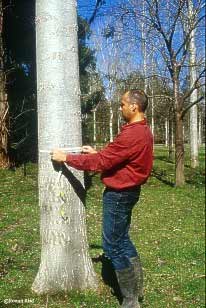|
Measurement and analysis

Being able to measure the characteristics of
a tree or forest provides a snapshot in time. Repeated measurements,
done over a number of years, can provide a better understanding
of how a forest is changing. Diameter growth, volume increments
and levels of competition can be monitored so that silvicultural
or harvesting operations are well timed.
Measurements can also be made of variables that
indicate the impact a forest has on agricultural productivity
or land degradation. For example, a farmer can use height
measurements of a shelterbelt to predict the area of the sheltered
zone. Similarly, the basal area of a forest is commonly proportional
to its canopy area and may be a useful guide to determining
tree water use in salinity recharge areas. This information
can be used to make better informed farm management decisions
that will enhance the value of the forest.
There is a range of relatively cheap equipment
that can be used to collect data on many aspects of farm forestry
including tree growth, soil chemical properties, water table
depths, pasture yields and wind speeds. Farmers may already
be collecting information on crop yields and animal production.
This information can be used to examine the impact that shelterbelts
or other forestry projects may have on production.
Some farmer networks are now compiling results
of tree measurements and other data from across their regions
to improve their planning and development work. In order to
compare results across a number of farms it is important to
adopt standard measurement and documentation procedures.
Tree
and forest measurement
Back to top
|
